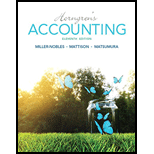
Horngren's Accounting (11th Edition)
11th Edition
ISBN: 9780133856781
Author: Tracie L. Miller-Nobles, Brenda L. Mattison, Ella Mae Matsumura
Publisher: PEARSON
expand_more
expand_more
format_list_bulleted
Textbook Question
Chapter 26, Problem P26.31APGA
Using payback, ARR, and NPVwith unequal
Mandel Manufacturing, Inc. has a manufacturing machine that needs attention. The company is considering two options. Option 1 is to refurbish the current machine at a cost of $1,100,000. I If refurbished, Mandel expects the machine to last another eight year and then have no residual value. Option 2 is to replace the machine at a cost of $2,200,000. A would last years and have no residual value. Mandel inflows from the two options:

Mandel uses straight-line
Requirements
- Compute the payback, the ARR, the
NPV , and the profitability index of these two options. - Which options should Mandel choose? Why?
Expert Solution & Answer
Want to see the full answer?
Check out a sample textbook solution
Students have asked these similar questions
Hello tutor solve this question accounting
I need help with this problem and accounting
None
Chapter 26 Solutions
Horngren's Accounting (11th Edition)
Ch. 26 - Prob. 1QCCh. 26 - Prob. 2QCCh. 26 - Prob. 3QCCh. 26 - Prob. 4QCCh. 26 - Prob. 5QCCh. 26 - Prob. 6QCCh. 26 - Prob. 7QCCh. 26 - The IRR is Learning Objective 4 the interest rate...Ch. 26 - Prob. 9QCCh. 26 - Ian Corp, is considering two expansion projects....
Ch. 26 - Prob. 1RQCh. 26 - Describe the capital budgeting process.Ch. 26 - Prob. 3RQCh. 26 - Prob. 4RQCh. 26 - Prob. 5RQCh. 26 - Prob. 6RQCh. 26 - What is the payback method of analyzing capital...Ch. 26 - Prob. 8RQCh. 26 - Prob. 9RQCh. 26 - What is the decision rule for payback?Ch. 26 - Prob. 11RQCh. 26 - What is the accounting rate of return?Ch. 26 - How is ARR calculated?Ch. 26 - Prob. 14RQCh. 26 - Prob. 15RQCh. 26 - What is an annuity? How does it differ from a lump...Ch. 26 - Prob. 17RQCh. 26 - Prob. 18RQCh. 26 - Prob. 19RQCh. 26 - Prob. 20RQCh. 26 - Prob. 21RQCh. 26 - Prob. 22RQCh. 26 - Prob. 23RQCh. 26 - Prob. 24RQCh. 26 - Prob. 25RQCh. 26 - Prob. 26RQCh. 26 - Prob. 27RQCh. 26 - Prob. 28RQCh. 26 - Prob. 29RQCh. 26 - Prob. 30RQCh. 26 - Prob. S26.1SECh. 26 - Prob. S26.2SECh. 26 - Prob. S26.3SECh. 26 - Prob. S26.4SECh. 26 - Prob. S26.5SECh. 26 - Prob. S26.6SECh. 26 - Prob. S26.7SECh. 26 - Prob. S26.8SECh. 26 - Prob. S26.9SECh. 26 - Prob. S26.10SECh. 26 - Prob. S26.11SECh. 26 - Prob. S26.12SECh. 26 - Prob. S26.13SECh. 26 - Prob. S26.14SECh. 26 - Prob. E26.15ECh. 26 - Prob. E26.16ECh. 26 - Prob. E26.17ECh. 26 - Prob. E26.18ECh. 26 - Prob. E26.19ECh. 26 - Using ARE to make capital investment decisions...Ch. 26 - Prob. E26.21ECh. 26 - Prob. E26.22ECh. 26 - Prob. E26.23ECh. 26 - Prob. E26.24ECh. 26 - Prob. E26.25ECh. 26 - Prob. E26.26ECh. 26 - Prob. E26.27ECh. 26 - Prob. E26.28ECh. 26 - Prob. P26.29APGACh. 26 - Prob. P26.30APGACh. 26 - Using payback, ARR, and NPVwith unequal cash flows...Ch. 26 - Prob. P26.32APGACh. 26 - Prob. P26.33APGACh. 26 - Prob. P26.34BPGBCh. 26 - Prob. P26.35BPGBCh. 26 - Using payback, ARR, and NPV with unequal cash...Ch. 26 - Prob. P26.37BPGBCh. 26 - Prob. P26.38CPCh. 26 - Prob. 1CPCh. 26 - Prob. 2CPCh. 26 - Prob. 3CPCh. 26 - Prob. 4CPCh. 26 - Prob. 26.1EICh. 26 - Prob. 26.1FC
Knowledge Booster
Learn more about
Need a deep-dive on the concept behind this application? Look no further. Learn more about this topic, accounting and related others by exploring similar questions and additional content below.Similar questions
- I want the correct answer with accountingarrow_forwardI want the correct answer with accounting questionarrow_forwardOriole Company sells product 2005WSC for $55 per unit and uses the LIFO method. The cost of one unit of 2005WSC is $52, and the replacement cost is $51. The estimated cost to dispose of a unit is $6, and the normal profit is 40% of selling price. At what amount per unit should product 2005WSC be reported, applying lower-of-cost-or-market?arrow_forward
arrow_back_ios
SEE MORE QUESTIONS
arrow_forward_ios
Recommended textbooks for you
- Principles of Accounting Volume 2AccountingISBN:9781947172609Author:OpenStaxPublisher:OpenStax College

 Cornerstones of Cost Management (Cornerstones Ser...AccountingISBN:9781305970663Author:Don R. Hansen, Maryanne M. MowenPublisher:Cengage Learning
Cornerstones of Cost Management (Cornerstones Ser...AccountingISBN:9781305970663Author:Don R. Hansen, Maryanne M. MowenPublisher:Cengage Learning  EBK CONTEMPORARY FINANCIAL MANAGEMENTFinanceISBN:9781337514835Author:MOYERPublisher:CENGAGE LEARNING - CONSIGNMENT
EBK CONTEMPORARY FINANCIAL MANAGEMENTFinanceISBN:9781337514835Author:MOYERPublisher:CENGAGE LEARNING - CONSIGNMENT Intermediate Financial Management (MindTap Course...FinanceISBN:9781337395083Author:Eugene F. Brigham, Phillip R. DavesPublisher:Cengage Learning
Intermediate Financial Management (MindTap Course...FinanceISBN:9781337395083Author:Eugene F. Brigham, Phillip R. DavesPublisher:Cengage Learning Excel Applications for Accounting PrinciplesAccountingISBN:9781111581565Author:Gaylord N. SmithPublisher:Cengage Learning
Excel Applications for Accounting PrinciplesAccountingISBN:9781111581565Author:Gaylord N. SmithPublisher:Cengage Learning

Principles of Accounting Volume 2
Accounting
ISBN:9781947172609
Author:OpenStax
Publisher:OpenStax College


Cornerstones of Cost Management (Cornerstones Ser...
Accounting
ISBN:9781305970663
Author:Don R. Hansen, Maryanne M. Mowen
Publisher:Cengage Learning

EBK CONTEMPORARY FINANCIAL MANAGEMENT
Finance
ISBN:9781337514835
Author:MOYER
Publisher:CENGAGE LEARNING - CONSIGNMENT

Intermediate Financial Management (MindTap Course...
Finance
ISBN:9781337395083
Author:Eugene F. Brigham, Phillip R. Daves
Publisher:Cengage Learning

Excel Applications for Accounting Principles
Accounting
ISBN:9781111581565
Author:Gaylord N. Smith
Publisher:Cengage Learning
Profitability index; Author: The Finance Storyteller;https://www.youtube.com/watch?v=Md5ocNqKHq8;License: Standard Youtube License